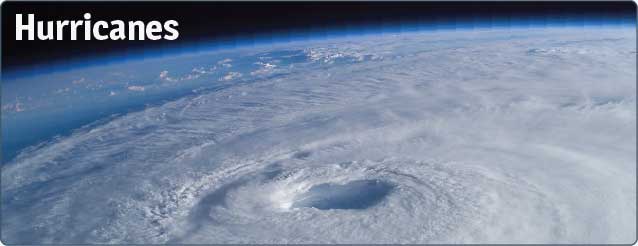
Photo Credit: NASA
Batten Down the Hatches
“Anyone who says they're not afraid at the time of a hurricane is either a fool or a liar, or a little bit of both.”
- Anderson Cooper
Rhode Island is no stranger to hurricanes and tropical storms, and the last few years are proof enough of that. Almost every year we see at least one or two storms make their way up the Atlantic coast. Some of these storms are memorable and ingrain themselves in our culture and local language. If you mention “Sandy” in a conversation everyone knows you are referring to the 2012 storm and not the cute blonde who sports retro short shorts. Other storms may cause minimal damage and blow through our memories as soon as the winds die down.
Climate change will likely spawn more history-making, culture-embedding storms as water temperatures continue to rise. Scientists project an increase in hurricane intensity and a decrease in storm frequency as a result of warmer waters. So although that may mean fewer storms, the memorable behemoths like the ones below may hit more often.
Hurricanes With the Biggest Impact on RI and New England Since 1900:
Estimated costs are the costs in the year of the storm; in parentheses is the cost adjusted for inflation in 2014 dollars.
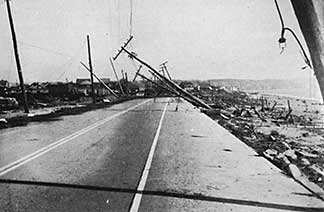
Credit: NOAA
Hurricane of 1938: “The Long Island Express”
Date: September 10-22, 1938
Strength at Landfall: Category 3
Maximum Wind Speeds: 186 mph
Tide Conditions: 12-15 foot storm surge
Estimated Cost: $600 million ($10 billion)
Casualties: 600+ deaths
In this Year: Gas cost $0.10 per gallon, Joe Louis vs Max Schmeling Boxing Match
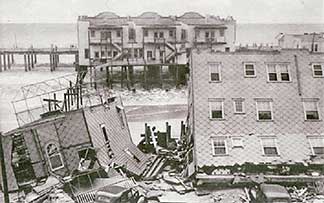
Credit: New Jersey State Police
Hurricane of 1944: “The Great Atlantic Hurricane”
Date: September 9-15, 1944
Strength at Landfall: Category 2
Maximum Wind Speeds: 86 mph
Tide Conditions: 2-foot storm surge
Estimated Cost: $100 million ($1.3 billion)
Casualties: 46 on land, over 300 at sea. Sunk navy destroyer USS Warrington.
In this Year: Gas was $0.15 per gallon, D-Day
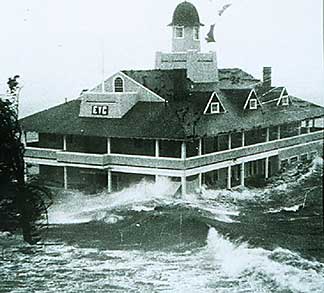
Credit: The University of Rhode Island
Hurricane Carol
Date: August 25-September 1, 1954
Strength at Landfall: Category 3
Maximum Wind Speeds: 135 mph
Tide Conditions: 14-foot storm surge
Estimated Cost: $462 million ($4 billion)
Casualties: 68
In this Year: Gas cost $0.29 per gallon, Brown vs Board of Education
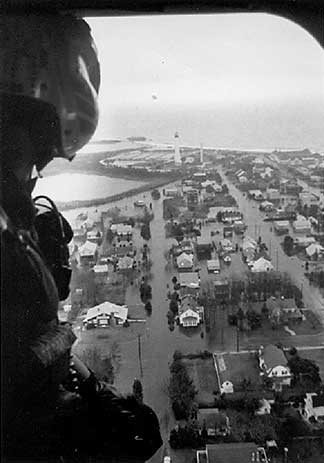
Credit: US Coast Guard
Hurricane Gloria
Date: September 15-28, 1985
Strength at Landfall: Category 1
Maximum Wind Speeds: 91 mph
Tide Conditions: 6-foot storm surge
Estimated Cost: $900 million ($2 billion)
Casualties: 14
In this Year: Gas was $1.09 per gallon, the wreck of the Titanic was discovered
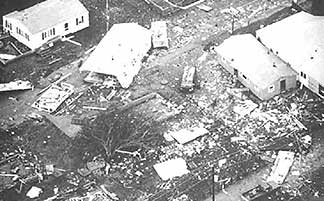
Credit: Steve Heaslip/Cape Cod Times
Hurricane Bob
Date: August 17-19, 1991
Strength at Landfall: Category 2
Maximum Wind Speeds: 125 mph
Tide Conditions: 5-8 foot storm surge
Estimated Cost: $1.5 billion ($2.6 billion)
Casualties: 6
In this Year: Gas was $1.12 per gallon, Operation Desert Storm
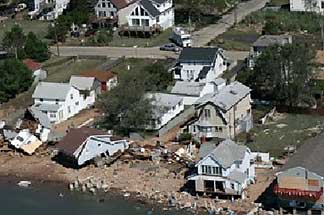
Credit: US Coast Guard
Hurricane Irene
Date: August 20-29, 2011
Strength at Landfall: Category 1
Maximum Wind Speeds: 65 mph
Tide Conditions: 6-9 foot storm surge
Estimated Cost: $15.8 billion ($16.6 billion)
Casualties: 56
In this Year: Gas was $3.52 per gallon, Osama Bin Laden assassination
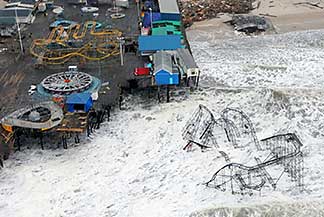
Credit: New Jersey National Guard
Superstorm Sandy
Date: October 22-31, 2012
Strength at Landfall: Tropical Storm
Maximum Wind Speeds: 86 mph
Tide Conditions: 3-5 foot storm surge
Estimated Cost: $65 billion ($67 billion)
Casualties: 147
In this Year: Gas was $3.91 per gallon, shooting at Sandy Hook Elementary School
If We Build It, Hurricanes May Come
When looking at the numbers from Superstorm Sandy, one thing stands out: $65 billion. How could a storm that was downgraded from a hurricane to a tropical storm possibly have caused that much damage? Surely the Hurricane of ’38, proclaimed to be the most destructive ever to hit New England, should have caused damage at least comparable to that done by Superstorm Sandy.
So how do we explain this seeming contradiction? There is one huge difference between 1938 and 2012: coastal infrastructure. There is just more infrastructure to be destroyed today than there was in 1938. Every new house, office building, road, bridge, supermarket, coffee shop, and frozen yogurt stand that is built is one more structure susceptible to hurricane damage.
As we continue to build more on our beloved coast, we are increasing our vulnerability to storms. If Superstorm Sandy caused billions of dollars in damage as a tropical storm, imagine what a category 5 hurricane would do today.
The Facts
- A storm of similar strength to Hurricane Katrina is currently expected every 86 years. If carbon dioxide levels double, which is predicted to happen by 2100, we could expect to see one every 28 years.
- Scientists anticipate a 5% increase in maximum hurricane wind speed for every 1° Celsius increase in sea temperature.
- Hurricane Katrina (category 3 hurricane at landfall) and Superstorm Sandy currently hold the record as the first and second most expensive tropical storms to hit the U.S.
- As potential storm intensity increases, more goods and services are vulnerable to storm surge and water damage.
- The estimated cost of hurricane damage roughly doubles with every 3 feet of sea level rise or, at the current rate of sea level rise, about 0.5% a year.
“People seemed to believe that technology had stripped hurricanes of their power to kill. No hurricane expert endorsed this view.”
- Erik Larson, author of “Isaac’s Storm: A Man, a Time, and the Deadliest Hurricane in History”
“It’s like a long-tailed cat in a room full of rocking chairs up here”
- Bill Wiltson, Maryland State Police dispatcher
“Louisiana loses 30 miles a year off our coast. We lost 100 miles last year off our coast thanks to Hurricanes Katrina and Rita. We have lost a size of land equivalent to the entire state of Rhode Island.”
- Bobby Jindal, Governor of Louisiana
News
Factoids
The Hurricane of 1938 and The Hurricane of 1944 both caused more than 10ft of flooding in downtown Providence.
In 1960 a hurricane barrier was built to protect Providence from future storms.
The Hurricane of 1938 completely wiped out Napatree point, destroying all 39 homes and killing 15 people.
Superstorm Sandy caused extensive damage to the Newport Cliff Walk causing its temporary closure.




